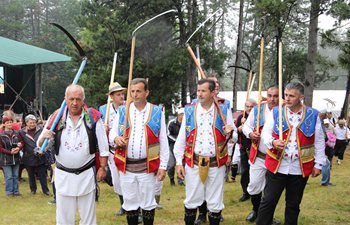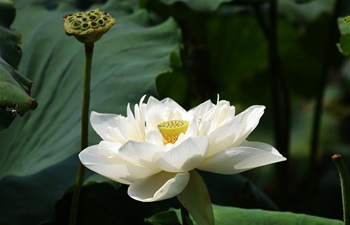HARBIN, July 13 (Xinhua) -- Carrying a bucket of small fish, Xu Hui starts his daily work patrolling the Zhalong National Nature Reserve, where red-crowned cranes roam in tall reeds.
Xu says the cranes are like his "beloved children" that fly across the vast marshland every morning and gather around him, waiting for him to feed them.
"I would feel upset if I couldn't see them every day," he says. "It's even worse than not seeing my own kid."
Located in northeast China's Heilongjiang Province and covering an area of 2,100 square km, the Zhalong National Nature Reserve is one of the world's largest breeding and protection base for the endangered red-crowned crane, which has a wild population of about 2,000 worldwide and is under top national protection in China.
Xu has worked as a ranger and breeder in the reserve for 13 years, mainly in charge of feeding and monitoring the cranes released into the wild to help them adapt to the new environment.
The job, which Xu calls "babysitting," usually starts at 5 a.m. and ends at 8 p.m.
Protecting wildlife is by no means easy in Heilongjiang, where a long and biting cold winter poses major challenges.
To make it worse, the red-crowned cranes are anything but docile, with high vigilance in the face of potential danger.
"The young crane would peck at anything that intrudes into its territory when it feels threatened," Xu says. "It takes time to gain trust from the cranes, and my efforts paid off."
Now the cranes fly toward him every morning as soon as they hear the sounds of his old motorcycle.
Xu says his love for the cranes has supported him through many difficulties.
"My favorite thing during work is to observe and take pictures of the cranes," he says. "They are just so graceful, whichever posture they are in. I can never get tired of watching them."
He said his happiest time comes in autumn when he finds some of the cranes leaving the nature reserve to winter in east China's coastal areas, which means they have fully adapted to the wild.
So far, the reserve has successfully released around 300 captive-bred red-crowned cranes into the wild to help maintain the species' genetic diversity, thanks to the efforts of its staff members such as Xu.
Xu has also stood witness to the improved protection of the crane habitat over the years.
Formerly a villager of Zhalong Village, where part of the nature reserve is located, Xu said many of his fellow villagers have been relocated to the nearby city with the help of the local government to make room for red-crowned cranes and other rare species.
Data from the reserve's administration bureau showed about 1,500 residents have been relocated out of the core area of the reserve since 2014.
Xu says he rarely saw red-crowned cranes in his village when he was a child and the birds then were very afraid of humans, always keeping a safe distance from the villagers. "With the improved environment of the reserve, they have grown much bolder in recent years," he said.
According to the reserve's administration bureau, more than 2.9 billion cubic meters of water has so far been diverted from nearby rivers to the reserve to prevent the degradation of the wetlands. The bureau has also established more protection stations to crack down on poaching.
Xu says local residents have also become increasingly aware of the significance of wildlife protection and wetland conservation in recent years.
"We have received many reports about injured cranes from local residents. The relationship between man and crane has become more harmonious," he says.

















